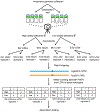Association mapping desiccation resistance within chromosomal inversions in the African malaria vector Anopheles gambiae
- PMID: 30252170
- PMCID: PMC6433559
- DOI: 10.1111/mec.14880
Association mapping desiccation resistance within chromosomal inversions in the African malaria vector Anopheles gambiae
Abstract
Inversion polymorphisms are responsible for many ecologically important phenotypes and are often found under balancing selection. However, the same features that ensure their large role in local adaptation-especially reduced recombination between alternate arrangements-mean that uncovering the precise loci within inversions that control these phenotypes is unachievable using standard mapping approaches. Here, we take advantage of long-term balancing selection on a pair of inversions in the mosquito Anopheles gambiae to map desiccation tolerance via pool-GWAS. Two polymorphic inversions on chromosome 2 of this species (denoted 2La and 2Rb) are associated with arid and hot conditions in Africa and are maintained in spatially and temporally heterogeneous environments. After measuring thousands of wild-caught individuals for survival under desiccation stress, we used phenotypically extreme individuals homozygous for alternative arrangements at the 2La inversion to construct pools for whole-genome sequencing. Genomewide association mapping using these pools revealed dozens of significant SNPs within both 2La and 2Rb, many of which neighboured genes controlling ion channels or related functions. Our results point to the promise of similar approaches in systems with inversions maintained by balancing selection and provide a list of candidate genes underlying the specific phenotypes controlled by the two inversions studied here.
Keywords: aridity tolerance; balancing selection; local adaptation; recombination.
© 2018 John Wiley & Sons Ltd.
Figures




References
-
- Andolfatto P, Depaulis F, Navarro A (2001) Inversion polymorphisms and nucleotide variability in Drosophila. Genetical Research, 77, 1–8. - PubMed
Publication types
MeSH terms
Grants and funding
LinkOut - more resources
Full Text Sources
Other Literature Sources
Medical

